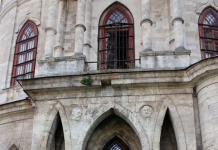A couple of weeks ago, hot water disappeared from all the taps of Novodvinsk - there is no need to look for any machinations of enemies, just hydraulic tests came to Novodvinsk, a procedure necessary to prepare the city's energy and utilities for the new drinking season. Without hot water, I somehow immediately felt like a villager - pots of boiling water on the stove - wash, shave, - wash dishes in cold water, etc.
At the same time, a question arose in my head: how is hot water “made”, and how does it get into the taps in our apartments?
Of course, all the city’s energy is “powered” by the Arkhangelsk Pulp and Paper Mill, more precisely at TPP-1, where I went to find out where the hot water and heat in our apartments come from. The chief power engineer of the Arkhangelsk Pulp and Paper Mill, Andrei Borisovich Zubok, agreed to help in my search and answered many of my questions.
Here, by the way, is the desktop of the chief power engineer of the Arkhangelsk Pulp and Paper Mill - a monitor where a wide variety of data is displayed, a multi-channel telephone that rang repeatedly during our conversation, a stack of documents...
Andrey Borisovich told me how “in theory” TPP-1, the main power plant of the plant and the city, works. The very abbreviation TPP - thermal power plant - implies that the station generates not only electricity, but also heat (hot water, heating), and heat generation is perhaps even more of a priority in our cold climate.
Scheme of operation of TPP-1: 
Any thermal power plant begins with the main control panel, where all the information about the processes occurring in the boilers, the operation of the turbines, etc. flows. 
Here, the operation of turbines, generators and boilers is visible on numerous indicators and dials. From here the station's production process is controlled. And this process is very complex; in order to understand everything, you need to study a lot. 

Well, nearby is the heart of TPP-1 - steam boilers. There are eight of them at TPP-1. These are huge structures, the height of which reaches 32 meters. It is in them that the main process of energy conversion occurs, thanks to which both electricity and hot water appear in our homes - steam production. 
But in it all starts with fuel. Coal, gas, and peat can act as fuel at different power plants. At TPP-1, the main fuel is coal, which is transported here from Vorkuta by rail.
Part of it is stored, the other part goes along conveyors to the station, where the coal itself is first crushed into dust and then fed through special “dust pipes” to steam boiler furnace . To ignite the boiler, fuel oil is used, and then, as pressure and temperature increase, it is transferred to coal dust.
A steam boiler is a unit for producing high-pressure steam from feedwater continuously supplied to it. This happens due to the heat released during fuel combustion. The boiler itself looks quite impressive. This structure weighs more than 1000 tons! The boiler capacity is 200 tons of steam per hour.

Externally, the boiler resembles a tangle of pipes, valves and some mechanisms. It’s hot next to the boiler, because the steam leaving the boiler has a temperature of 540 degrees.
There is also another boiler at TPP-1 - a modern Metso boiler installed several years ago with a Hybex grate. This power unit is controlled by a separate remote control.
The unit operates using innovative technology - fuel combustion in a bubble fluidized bed (Hybex). To produce steam, bark fuel (270 thousand tons per year) and sewage sludge (80 thousand tons per year) are burned here; it is brought here from wastewater treatment plants.


A modern boiler is also a huge structure, the height of which is more than 30 meters.
Or bark fuel enters the boiler through these conveyors.
And from here, after preparation, the fuel mixture goes directly into the boiler furnace.
There is an elevator in the new boiler building at TPP-1. But there are no floors in the form familiar to an ordinary city dweller - there areservice mark height- so the elevator moves from mark to mark.
More than 700 people work at the station. There is enough work for everyone - the equipment requires maintenanceand constant monitoring by staff. Working conditions at the station are difficult- high temperatures, humidity, noise, coal dust.
And here workers are preparing a site for the construction of a new boiler - its construction will begin next year.
Here the water for the boiler is prepared. In automatic mode, the water is softened in order to reduce the negative impact on the boiler and turbine blades (already at the time when the water turns into steam).

And this is the turbine hall - steam from the boilers comes here, here it turns powerful turbines (there are five in total).
Side view: 
In this hall, steam works: passing through superheaters, the steam is heated to a temperature of 545 degrees and enters the turbine, where under its pressure the turbine generator rotor rotates and, accordingly, electricity is generated.
Lots of pressure gauges.
But here it is - a turbine, where the steam works and “turns” the generator. This is turbine No. 7 and, accordingly, generator No. 7.
Eighth generator and eighth turbine. The power of the generators is different, but in total they are capable of producing about 180 MW of electricity - this electricity is enough for the needs of the station itself (which is about 16%), and for the needs of the production of the Arkhangelsk Pulp and Paper Mill, and for providing “third-party consumers” (about 5% of generated energy).
The interweaving of pipes is fascinating.
Hot water for heating (network) is obtained by heating water with steam in heat exchangers (boilers). It is pumped into the network by these pumps - there are eight of them at TPP-1. Water “for heating,” by the way, is specially prepared and purified and, at the exit from the station, meets the requirements for drinking water. Theoretically, this water can be drunk, but still it is not recommended to drink it due to the presence of a large number of corrosion productsin heating pipes.


And in these towers - section of the chemical workshop of TPP-1,- water is prepared and added to the heating system, because part of the hot water is consumed - it needs to be replenished.
Then the heated water (coolant) flows through pipelines of various cross-sections, because TPP-1 heats not only the city, but also the industrial premises of the plant.
And electricity “leaves” the station throughthrough electrical distribution devices and transformers and is transmitted to the power system of the plant and the city.

Of course, there is a pipe at the station - that very “cloud factory”. There are three such pipes at TPP-1. The highest is more than 180 meters. As it turned out, the pipe is really a hollow structure where gas ducts from various boilers converge.Before entering the chimney, flue gases undergo an ash removal system. On a new boiler this happens in the electric precipitator.The effective degree of flue gas purification is 99.7%.On coal boilers, cleaning is done with water - this system is less efficient, but still most of the “emissions” are captured.

Today, renovations are in full swing at TPP-1: and if the building can be repaired at any time...
Therefore, major repairs of boilers or turbines can only be carried out in the summer during periods of reduced loads. By the way, this is precisely why “hydraulic tests” are carried out. A programmatic increase in the load on heat supply systems is necessary, firstly, to check the reliability of utility communications, and, secondly, power engineers have the opportunity to “drain” the coolant from the system and replace, for example, a section of pipe. Repair of power equipment is an expensive undertaking that requires special qualifications and permission from specialists.
Outside the plant, hot water (also known as coolant) flows through pipes - three “exits” to the city ensure uninterrupted operation of the city’s heating system. The system is closed, water constantly circulates in it. In the coldest time of the year - the temperature of the water leaving the station is 110 degrees Celsius, the coolant returns, having cooled by 20-30 degrees. In summer, the water temperature is reduced - the norm at the exit from the station is 65 degrees Celsius.
By the way, hot water and heating are turned off not at thermal power plants, but directly in houses - this is done by management companies. The thermal power plant “turns off” the water only once - after hydraulic tests, in order to make repairs. After repairs, power engineers gradually fill the system with water - the city has special mechanisms for bleeding air from the system - just like in batteries in an ordinary residential building.
The final point of hot water is the same tap in any of the city apartments, only now there is no water in it - hydraulic tests.
This is how difficult it is to “do” something without which it is difficult to imagine the life of a modern city dweller - hot water.
Thermal station a power plant that generates electrical energy by converting the chemical energy of fuel into the mechanical energy of rotation of the electric generator shaft.
Main nodes
thermal power plants
boiler plant
generator
cooling towers
cooling towers
In addition, the thermal power plant includes: catalysts, lubricating oil supply system, ventilation system, fire extinguishing systems, distribution boards, thermal power plant transformers, network monitoring devices, control units.
There are thermal steam turbine power plants (TPES), gas turbine power plants (GTPP) and combined cycle power plants (CGPP).
Among thermal power plants, thermal steam turbine power plants (TSPS) predominate, in which thermal energy is used in a steam generator to produce high-pressure water steam, which rotates a steam turbine rotor connected to the rotor of an electric generator (usually a synchronous generator).
The fuel used at such thermal power plants is coal (mainly), fuel oil, natural gas, lignite, peat, and shale. Their efficiency reaches 40%, power – 3 GW.
TPES that have condensing turbines as a drive for electric generators and do not use the heat of exhaust steam to supply thermal energy to external consumers are called condensing power plants (the official name in the Russian Federation is the State District Electric Station, or GRES). TPES equipped with heating turbines and releasing the heat of exhaust steam to industrial or municipal consumers are called combined heat and power plants (CHP). When constructing a thermal power plant, it is necessary to take into account the proximity of heat consumers in the form of hot water and steam, since heat transfer over long distances is not economically feasible.
Fuel used . The following fuels can be used in thermal power plants: oil, fuel oil, natural gas and coal. The main elements of fuel are carbon and hydrogen, with sulfur and nitrogen present in smaller quantities. The fuel may contain compounds of other elements, for example, metals (sulfides and oxides).
There are four known types of coal. In order of increasing carbon content, and thus calorific value, these types are arranged as follows: peat, brown coal, bituminous (fat) coal or hard coal and anthracite. In the operation of thermal power plants, mainly the first two types are used.
Coal is not chemically pure carbon; it also contains inorganic material (brown coal contains up to 40% carbon), which remains after the combustion of coal in the form of ash. Coal may contain sulfur, sometimes as iron sulfide and sometimes as part of the organic components of coal. Coal usually contains arsenic, selenium, and radioactive elements. In fact, coal turns out to be the dirtiest of all fossil fuels.
When coal is burned, carbon dioxide, carbon monoxide, as well as large quantities of sulfur oxides, suspended particles and nitrogen oxides are formed. Sulfur oxides damage trees, various materials and have a harmful effect on people.
The particles released into the atmosphere when coal is burned in power plants are called "fly ash." Ash emissions are strictly controlled. About 10% of suspended particles actually enter the atmosphere.
A 1000 MW coal-fired power plant burns 4-5 million tons of coal per year.
Since there is no coal mining in the Altai Territory, we will assume that it is brought from other regions, and roads are built for this purpose, thereby changing the natural landscape.
Fuel oil is used for heating residential buildings, schools, hospitals and as fuel at thermal power plants due to its relatively low price and low sulfur content.
Unlike coal and oil, natural gas contains virtually no sulfur. From this point of view, gas is an environmentally friendly fuel. However, in the case of gas use, nature is harmed when laying thousands of kilometers of gas pipelines, especially in the northern regions where the main gas deposits are concentrated.
Physico-chemical basis of the ongoing reactions. When fuel burns, the carbon and hydrogen it contains form the corresponding oxides, which can be represented by the equations:
C + O 2 CO 2 + Q
2H + 1 / 2 O H 2 O + Q
If the amount of oxygen is not enough to completely oxidize carbon, then the reaction occurs
C + 1 / 2 O 2 CO 2 + Q
or part of the resulting CO 2 reacts with carbon, forming carbon monoxide:
C + CO 2 2CO 2 - Q
Thus, under conditions of lack of oxygen, more CO can be released. In addition, compared to complete combustion, the amount of heat released is reduced .
When oil or coal is incompletely burned, volatile organic compounds are removed, forming one of the components of the smoke, which is especially common in small stoves. In large furnaces, highly flammable volatile compounds are ignited by radiation from the hot walls of the furnace and burn completely to CO 2 and H 2 O.
Sulfur and nitrogen, which are part of coal and oil, also burn to form oxides. When sulfur burns, it usually produces sulfur dioxide:
S + O 2 SO 2
To a lesser extent, further oxidation occurs in the flame:
2SO 2 + O 2 2SO 3 + Q
The oxides formed in a normal flame contain only about 1% SO 3 . Although sulfuric anhydride SO 3 is stable at low temperatures, the rate of its formation in the absence of catalysts is insignificant. At temperatures characteristic of a flame, sulfur dioxide SO 2 is more stable.
During combustion, nitrogen monoxide NO is also released. The source of its formation is partially the nitrogen contained in the fuel, during the combustion of which 18-80% of the nitrogen is oxidized. Nitrogen monoxide is also formed as a result of the reaction between atmospheric oxygen and nitrogen in the flame and in the adjacent layers. The reaction that occurs can be represented as follows:
N 2 + O 2 2NO - Q
Once in the atmosphere, nitrogen monoxide is slowly converted into dioxide through complex photochemical reactions. In simplified form they come down to the reaction
NO + 1 / 2 O 2 NO 2
Thus, the exhaust gases of thermal power engineering include CO 2, CO, H 2 O (steam), SO 2 (less often SO 3), NO, NO 2 and other substances, the entry of which into the air causes great harm to all components of the biosphere.
Boiler plant . Boiler installation - a set of devices for producing water steam under pressure. The boiler installation consists of a furnace in which organic fuel is burned, a combustion chamber through which combustion products pass into the chimney, and a steam boiler in which water boils. The part of the boiler that comes into contact with the flame during heating is called the heating surface. The performance of a boiler is measured by the amount of water that it is able to evaporate within 1 hour at a certain temperature and pressure.
The boiler plant produces high-pressure steam, which goes to the steam turbine - the main engine of the thermal power plant. In the turbine, the steam expands, its pressure drops, and the latent energy is converted into mechanical energy. A steam turbine turns a generator that produces electric current.
Principle of operation. The diagram of the thermal power plant is shown in Figure D.1.

Figure D.1. Thermal power plant diagram
Feed water under high pressure, fuel and atmospheric air for combustion are supplied to the boiler using a feed pump. The combustion process takes place in the boiler furnace - the chemical energy of the fuel is converted into thermal and radiant energy. Feed water flows through a pipe system located inside the boiler. The burning fuel is a powerful source of heat, which is transferred to the feedwater, which is heated to boiling point and evaporates. The resulting steam in the same boiler is overheated above the boiling point, to approximately 540 °C with a pressure of 13–24 MPa, and is supplied to the steam turbine through one or more pipelines.
The steam turbine, electric generator and exciter make up the whole turbine unit. In a steam turbine, steam expands to a very low pressure (about 20 times less than atmospheric pressure), and the potential energy of the compressed and heated steam is converted into kinetic energy of rotation of the turbine rotor. The turbine drives an electric generator, which converts the kinetic energy of rotation of the generator rotor into electric current. An electric generator consists of a stator, in the electrical windings of which current is generated, and a rotor, which is a rotating electromagnet powered by an exciter.
The condenser serves to condense the steam coming from the turbine and create a deep vacuum, due to which the steam expands in the turbine. It creates a vacuum at the outlet of the turbine, so the steam, entering the turbine at high pressure, moves to the condenser and expands, which ensures that its potential energy is converted into mechanical work.
The power units of a thermal power plant produce a large amount of heat, and various liquids are used to cool them. In thermal power plants, a heat exchanger is installed along the path of the coolant, in which the engine cooling liquid transfers most of its heat to another liquid - the coolant. Water is usually used as a coolant, the forced movement of which through the heating system is ensured by circulation pumps. Installing heat exchangers more than doubles the overall efficiency of a thermal power plant compared to a conventional power plant of the same capacity - the energy utilization rate reaches 90%. In a simple power plant, without using heat, only 22-43% of energy is used to produce electricity, the rest is losses.
Waste . The release of flue gases into the atmosphere is the most dangerous impact of a thermal power plant on the environment.
Education particulate matter (smoke) during combustion depends on the content of solid non-combustible materials in the fuel and on the completeness of carbon combustion. In the smoke of boiler houses operating under overload (with incomplete combustion of fuel in them), there are unburned carbon particles and inorganic substances. On the contrary, coal-fired stoves, especially when it is atomized, produce a significant amount of smoke. Particles emitted into the atmosphere when coal is burned at thermal power plants are called fly ash.
To collect ash from flue gases, filters of various types are installed after blower fans (cyclones, scrubbers, electric precipitators, bag fabric filters), which retain 90-99% of solid particles. However, they are not suitable for cleaning smoke from harmful gases. Abroad, and recently at domestic power plants (including gas-oil power plants), systems are being installed for gas desulfurization with lime or limestone (so-called deSOx) and catalytic reduction of nitrogen oxides with ammonia (deNOx). The purified flue gas is emitted by a smoke exhauster into a chimney, the height of which is determined from the dispersion conditions
Additional heat during the operation of a thermal power plant can be obtained by utilizing the heat of exhaust gases, because their temperature at the engine outlet reaches 500 - 600 °C. To use this heat, an additional heat exchanger is installed on the exhaust pipe, into which water is supplied from the first heat exchanger. In this case, it is possible not only to use more heat - the temperature of the exhaust gases drops to ~120 °C, but also to significantly increase the temperature of the coolant.
In addition to emissions into the atmosphere, it is necessary to take into account that in places where waste from coal plants is concentrated there is a significant increase in background radiation, which can lead to doses exceeding the maximum permissible. Part of the natural activity of coal is concentrated in ash, which accumulates in huge quantities at power plants. Radioactive elements and their decay products are found in the fly ash of thermal power plants. The reason is that ordinary coal contains the radioactive carbon isotope C-14, impurities of potassium-40, uranium-238, thorium-232 and their decay products, the specific activity of each of which ranges from several units to several hundred Bq/kg. During the operation of thermal power plants, these radionuclides, together with fly ash and other combustion products, enter the ground layer of the atmosphere, soil and water bodies. The amount of radionuclides released into the atmosphere depends on the ash content of coal and the efficiency of cleaning filters of combustion devices. CHP plants of various types emit from 1 to 20% of the total amount of ash produced into the atmosphere.
Solid waste from thermal power plants - ash and slag - is close to metallurgical slag in composition. Their output currently amounts to about 70 million tons per year, and approximately half of this waste is ash from burning coal. The degree of use of ash and slag waste does not exceed 1.5-2%. In terms of chemical composition, this waste consists of 80 - 90% SiO 2, A1 2 O 3, FeO, Fe 2 O 3, CaO, MgO with significant fluctuations in their content. In addition, this waste includes the remains of unburned fuel particles (0.5-20%), compounds of titanium, vanadium, germanium, gallium, sulfur, and uranium. The chemical composition and properties of ash and slag waste determine the main directions of its use.
The bulk of the used part of slag and ash serves as raw material for the production of building materials. Thus, thermal power plant ash is used for the production of artificial porous fillers - ash and agloporite gravel. At the same time, to produce agloporite gravel, ash containing no more than 5-10% combustibles is used, and to produce ash gravel, the content of combustibles in the ash should not exceed 3%. The firing of raw granules in the production of agloporite gravel is carried out on the grates of sintering machines, and in the production of ash gravel - in rotary kilns. It is also possible to use thermal power plant ashes for the production of expanded clay gravel.
Ashes and slags from the combustion of brown and hard coals, peat and shale, containing no more than 5% of unburned fuel particles, can be widely used for the production of sand-lime bricks as a binder if they contain at least 20% CaO or as a siliceous filler, if they contain no more than 5% CaO. Ashes with a high content of coal particles are successfully used for the production of clay (red) bricks. Ash in this case plays the role of both a waste and fuel additive. The content of introduced ash depends on the type of clay used and is 15–50%, and in some cases can reach 80%.
Acid ash and slag waste, as well as basic waste with a free lime content of ≤10%, is used as an active mineral additive in the production of cement. The content of flammable substances in such additives should not exceed 5%. The same waste can be used as a hydraulic additive (10-15%) to cement. Ash with a free CaO content of no more than 2-3% is used to replace part of the cement in the process of preparing various concretes. In the production of autoclaved cellular concrete, shale ash containing ^14% free CaO is used as a binder component, and ash from coal combustion with a combustible content of 3-5% is used as a siliceous component. The use of ash and slag waste in these areas is not only economically profitable, but also improves the quality of the corresponding products.
Ash and slag waste is used in road construction. They serve as good raw materials for the production of mineral wool products. The high content of CaO in the ash of shale and peat allows it to be used to reduce acidity - liming of soils. Plant ash is widely used in agriculture as a fertilizer due to its significant content of potassium and phosphorus, as well as other macro- and microelements necessary for plants. Certain types of ash and slag waste are used as wastewater treatment agents.
In some cases, the concentrations of metals in ash are such that their extraction becomes economically profitable. The concentration of Sr, V, Zn, Ge reaches 10 kg per 1 ton of ash. The uranium content in the ash of brown coals of some deposits can reach 1 kg/t. In oil ash, the U2O5 content in some cases reaches 65%; in addition, Mo and Ni are present in significant quantities. In this regard, the extraction of metals is another direction for processing such waste. Rare and trace elements (for example, Ge and Ga) are currently extracted from the ash of some coals.
However, despite the availability of developed processes for recycling fuel ash and slag waste, the level of their use still remains low. On the other hand, modern technological use of fuel energy (compared, for example, with its use in powerful thermal power plants) is ineffective. When addressing issues of environmental protection, in particular from the harmful effects of solid and gaseous waste, thermal power plants follow the path of integrated energy technology use of fuels. Combining large industrial installations for the production of metals and other technical products (in particular chemicals), as well as process gases with powerful thermal power plant furnaces will make it possible to completely utilize both the organic and mineral parts of the fuel, increase the degree of heat utilization, and sharply reduce fuel consumption.
Some progress towards the integrated use of fuels has already been achieved. Thus, in our country, an original technology for multi-stage combustion of high-sulfur fuel oils has been developed and implemented, according to which, first, incomplete combustion is carried out - gasification of the fuel. The resulting gas is cooled, purified from sulfur and ash compounds and fed into the combustion chamber of a power plant or into the furnace of a steam boiler. The heat released when the gas is cooled serves to produce high-temperature steam. Sulfur compounds are sent to the production of sulfuric acid or elemental sulfur. Vanadium, nickel and other metals are isolated from the ash.
Impact of thermal power plants on the environment.
Atmosphere . When burning fuel, a large amount of oxygen is consumed, and a significant amount of combustion products is also released, such as fly ash, gaseous oxides of carbon, sulfur and nitrogen, some of which have high chemical activity, and radioactive elements contained in the original fuel. Large amounts of heavy metals are also released, including mercury and lead.
However, at present, thanks to the optimal energy conversion mode and the use of catalyst equipment, modern thermal power plants are characterized by low emissions of harmful substances into the atmosphere.
The soil . Disposal of large masses of ash requires a lot of space. These pollution are reduced by the use of ash and slag as building materials.
Fly ash emissions can pollute the soil within a radius of several tens of kilometers from thermal power plants. Around a modern thermal power plant with a good gas purification system, radioactive contamination of the soil is negligible.
Hydrosphere. The technical water supply system supplies a large amount of cold water to cool the turbine condensers. Systems are divided into direct-flow, circulating and mixed. In once-through systems, water is pumped from a natural source (usually a river) and discharged back after passing through a condenser. At the same time, the water heats up by approximately 8–12 °C, which in some cases changes the biological state of reservoirs. In recirculating systems, water circulates under the influence of circulation pumps and is cooled by air. Cooling can be carried out on the surface of cooling reservoirs or in artificial structures: spray pools or cooling towers.
The chemical water treatment system provides chemical purification and deep desalting of water entering steam boilers and steam turbines to avoid deposits on the internal surfaces of equipment. In addition, at thermal power plants, multi-stage systems are created for treating wastewater contaminated with petroleum products, oils, equipment washing and rinsing water, storm and melt runoff.
Thermal pollution of water occurs when open cooling is used. What may be the environmental consequences of thermal pollution for aquatic organisms? Firstly, there have been cases of fish deaths, although this is a relatively rare occurrence. Secondly, temperature can affect the reproductive functions of aquatic organisms. For example, adult trout can survive in warm water, but they will not reproduce. Under the influence of rising temperatures, some insects appear earlier, which then die because they lack food at this time of year. This means that later there will not be enough food for those who feed on these insects, etc. Changes in the behavior of fish under the influence of heat shock can occur, allowing predators to easily grab them. In addition, heat-shocked fish will be more susceptible to disease. In the long term, some of the listed effects can be as destructive for the population as direct death from overheating of water.
Temperature can affect the structure of an entire aquatic community. The influx of excess heat simplifies aquatic ecosystems, and the number of different species decreases. The most dangerous thermal impacts on ecosystems come from power plants located in warmer climates, as organisms are exposed to temperature conditions close to their upper temperature limit of survival.
Advantages and disadvantages of thermal power plants.
|
ADVANTAGES |
FLAWS |
|
1. Can be used not only for power supply, but also for heat supply of residential and public buildings, industrial enterprises |
1. The creation, transmission and use of electrical energy lead to electromagnetic pollution of the environment. |
|
2. Due to the simultaneous generation of electricity and heat supply, thermal power plants are the most efficient and economical during long-term operation. The maximum thermal output of the heating system is needed for several months of the year, and to satisfy approximately 60% of the heat consumption, only 20% of the installed thermal output is required. |
2. Coal and fly ash contain significant amounts of radioactive impurities (226 Ra, 228 Ra, etc.). An annual emission into the atmosphere in the area where a thermal power plant with a capacity of 1 GW is located leads to the accumulation of radioactivity on the soil that is 10-20 times greater than the radioactivity of the annual emissions of a nuclear power plant of the same power. |
|
3. Simultaneously with the generation of electricity by the thermal power plant, heating systems are also activated. Thermal power plants provide a mode of covering the peak demand for electricity while simultaneously generating heat. |
3. A coal-fired thermal power plant generating electricity with a capacity of 1 GW annually consumes 3 million tons of coal, emitting 7 million tons of carbon dioxide, 120 thousand tons of sulfur dioxide, 20 thousand tons of nitrogen oxides and 750 thousand tons of ash into the environment . |
|
4. The largest contribution, namely 80% of all electricity produced in our country, comes from thermal power plants. |
4. The combustion of carbon-containing fuels leads to the appearance of carbon dioxide CO 2, which is released into the atmosphere and contributes to the creation of the greenhouse effect. |
|
5. Unlike hydroelectric power stations, thermal power plants can be built anywhere, thereby bringing the sources of electricity closer to the consumer and distributing thermal power plants evenly across the territory of the country or economic region. |
5. The combustion of carbon-containing fuels leads to the appearance of sulfur and nitrogen oxides. They enter the atmosphere and, after reacting with water vapor in the clouds, form sulfuric and nitric acids, which fall to the ground with rain. This is how acid rain occurs. |
|
6. Thermal power plants operate on almost all types of organic fuel - various coals, shale, liquid fuel and natural gas. |
6. Thermal energy requires the seizure of territories for fuel extraction, its transportation, the location of power plants and power lines, and for slag dumps |
At thermal power plants, people receive almost all the energy they need on the planet. People have learned to receive electric current in a different way, but still do not accept alternative options. Even if it is unprofitable for them to use fuel, they do not refuse it.
What is the secret of thermal power plants?
Thermal power plants It is no coincidence that they remain indispensable. Their turbine produces energy in the simplest way, using combustion. Due to this, it is possible to minimize construction costs, which are considered completely justified. There are such objects in all countries of the world, so one should not be surprised at the spread.
Operating principle of thermal power plants built on burning huge volumes of fuel. As a result, electricity appears, which is first accumulated and then distributed to certain regions. Thermal power plant patterns remain almost constant.
What fuel is used at the station?
Each station uses a separate fuel. It is specially supplied so that the workflow is not disrupted. This point remains one of the problematic ones, as transportation costs arise. What types of equipment does it use?
- Coal;
- Oil shale;
- Peat;
- Fuel oil;
- Natural gas.
Thermal circuits of thermal power plants are built on a specific type of fuel. Moreover, minor changes are made to them to ensure maximum efficiency. If they are not done, the main consumption will be excessive, and therefore the resulting electric current will not be justified.
Types of thermal power plants
The types of thermal power plants are an important issue. The answer to it will tell you how the necessary energy appears. Today, serious changes are gradually being made, where alternative types will be the main source, but so far their use remains inappropriate.
- Condensing (IES);
- Combined heat and power plants (CHP);
- State district power plants (GRES).
The thermal power plant will require a detailed description. The types are different, so only consideration will explain why construction of such a scale is carried out.
Condensing (IES)
Types of thermal power plants begin with condensing ones. Such thermal power plants are used exclusively for generating electricity. Most often, it accumulates without immediately spreading. The condensation method provides maximum efficiency, so similar principles are considered optimal. Today, in all countries, there are separate large-scale facilities that supply vast regions.
 Nuclear plants are gradually appearing, replacing traditional fuel. Only replacement remains an expensive and time-consuming process, since working on fossil fuels differs from other methods. Moreover, shutting down a single station is impossible, because in such situations entire regions are left without valuable electricity.
Nuclear plants are gradually appearing, replacing traditional fuel. Only replacement remains an expensive and time-consuming process, since working on fossil fuels differs from other methods. Moreover, shutting down a single station is impossible, because in such situations entire regions are left without valuable electricity.
Combined heat and power plants (CHP)
CHP plants are used for several purposes at once. They are primarily used to generate valuable electricity, but burning fuels also remains useful for generating heat. Due to this, cogeneration power plants continue to be used in practice.
An important feature is that such thermal power plants are superior to other types with relatively low power. They supply specific areas, so there is no need for bulk supplies. Practice shows how beneficial such a solution is due to the laying of additional power lines. The operating principle of a modern thermal power plant is unnecessary only because of the environment.
State district power plants
General information about modern thermal power plants GRES is not noted. Gradually they remain in the background, losing their relevance. Although state-owned district power plants remain useful in terms of energy output.
 Different types of thermal power plants provide support to vast regions, but still their power is insufficient. During the Soviet era, large-scale projects were carried out, which are now being closed. The reason was inappropriate use of fuel. Although their replacement remains problematic, since the advantages and disadvantages of modern thermal power plants are primarily noted for the large volumes of energy.
Different types of thermal power plants provide support to vast regions, but still their power is insufficient. During the Soviet era, large-scale projects were carried out, which are now being closed. The reason was inappropriate use of fuel. Although their replacement remains problematic, since the advantages and disadvantages of modern thermal power plants are primarily noted for the large volumes of energy.
Which power plants are thermal? Their principle is based on burning fuel. They remain indispensable, although calculations are actively underway for equivalent replacement. Thermal power plants continue to prove their advantages and disadvantages in practice. Because of which their work remains necessary.
What is it and what are the operating principles of thermal power plants? The general definition of such objects sounds approximately as follows - these are power plants that process natural energy into electrical energy. Fuel of natural origin is also used for these purposes.
The operating principle of thermal power plants. Short description
Today, it is precisely at such facilities that combustion is most widespread that releases thermal energy. The task of thermal power plants is to use this energy to produce electrical energy.
The operating principle of thermal power plants is not only the generation but also the production of thermal energy, which is also supplied to consumers in the form of hot water, for example. In addition, these energy facilities generate about 76% of all electricity. This widespread use is due to the fact that the availability of fossil fuels for the operation of the station is quite high. The second reason was that transporting fuel from the place of its extraction to the station itself is a fairly simple and streamlined operation. The operating principle of thermal power plants is designed in such a way that it is possible to use the waste heat of the working fluid for its secondary supply to the consumer.
Separation of stations by type
It is worth noting that thermal stations can be divided into types depending on what kind of heat they produce. If the principle of operation of a thermal power plant is only to produce electrical energy (that is, it does not supply thermal energy to the consumer), then it is called condensing power plant (CES).

Facilities intended for the production of electrical energy, for the supply of steam, as well as the supply of hot water to the consumer, have steam turbines instead of condensing turbines. Also in such elements of the station there is an intermediate steam extraction or a backpressure device. The main advantage and operating principle of this type of thermal power plant (CHP) is that waste steam is also used as a heat source and supplied to consumers. This reduces heat loss and the amount of cooling water.
Basic operating principles of thermal power plants
Before moving on to considering the principle of operation itself, it is necessary to understand what kind of station we are talking about. The standard design of such facilities includes a system such as intermediate superheating of steam. It is necessary because the thermal efficiency of a circuit with intermediate superheating will be higher than in a system without it. In simple terms, the operating principle of a thermal power plant with such a scheme will be much more efficient with the same initial and final specified parameters than without it. From all this we can conclude that the basis of the station’s operation is organic fuel and heated air.

Scheme of work
The operating principle of the thermal power plant is constructed as follows. The fuel material, as well as the oxidizer, whose role is most often played by heated air, is supplied in a continuous flow into the boiler furnace. Substances such as coal, oil, fuel oil, gas, shale, and peat can act as fuel. If we talk about the most common fuel on the territory of the Russian Federation, it is coal dust. Further, the operating principle of thermal power plants is constructed in such a way that the heat generated by burning fuel heats the water in the steam boiler. As a result of heating, the liquid is converted into saturated steam, which enters the steam turbine through the steam outlet. The main purpose of this device at the station is to convert the energy of the incoming steam into mechanical energy.

All elements of the turbine that can move are closely connected to the shaft, as a result of which they rotate as a single mechanism. To make the shaft rotate, a steam turbine transfers the kinetic energy of steam to the rotor.
Mechanical part of the station operation
The design and principle of operation of a thermal power plant in its mechanical part is associated with the operation of the rotor. The steam that comes from the turbine has very high pressure and temperature. Because of this, high internal energy of steam is created, which flows from the boiler into the turbine nozzles. Jets of steam, passing through the nozzle in a continuous flow, at high speed, which is often even higher than sound speed, act on the turbine blades. These elements are rigidly fixed to the disk, which, in turn, is closely connected to the shaft. At this point in time, the mechanical energy of the steam is converted into the mechanical energy of the rotor turbines. If we talk more precisely about the operating principle of thermal power plants, then the mechanical impact affects the rotor of the turbogenerator. This is due to the fact that the shaft of a conventional rotor and generator are tightly coupled to each other. And then there is a fairly well-known, simple and understandable process of converting mechanical energy into electrical energy in a device such as a generator.

Steam movement after the rotor
After the water vapor passes the turbine, its pressure and temperature drop significantly, and it enters the next part of the station - the condenser. Inside this element, the vapor is converted back into liquid. To perform this task, there is cooling water inside the condenser, which is supplied there through pipes running inside the walls of the device. After the steam is converted back into water, it is pumped out by a condensate pump and enters the next compartment - the deaerator. It is also important to note that the pumped water passes through regenerative heaters.
The main task of the deaerator is to remove gases from the incoming water. Simultaneously with the cleaning operation, the liquid is heated in the same way as in regenerative heaters. For this purpose, the heat of the steam is used, which is taken from what goes into the turbine. The main purpose of the deaeration operation is to reduce the oxygen and carbon dioxide content in the liquid to acceptable values. This helps reduce the rate of corrosion on the paths through which water and steam are supplied.

Coal stations
There is a high dependence of the operating principle of thermal power plants on the type of fuel used. From a technological point of view, the most difficult substance to implement is coal. Despite this, raw materials are the main source of power at such facilities, the number of which is approximately 30% of the total share of stations. In addition, it is planned to increase the number of such objects. It is also worth noting that the number of functional compartments required for the operation of the station is much greater than that of other types.
How do thermal power plants run on coal fuel?
In order for the station to operate continuously, coal is constantly brought in along the railway tracks, which is unloaded using special unloading devices. Then there are elements such as through which unloaded coal is supplied to the warehouse. Next, the fuel enters the crushing plant. If necessary, it is possible to bypass the process of delivering coal to the warehouse and transfer it directly to the crushers from unloading devices. After passing this stage, the crushed raw materials enter the raw coal bunker. The next step is to supply the material through feeders to the pulverized coal mills. Next, the coal dust, using a pneumatic transportation method, is fed into the coal dust bunker. Along this path, the substance bypasses elements such as a separator and a cyclone, and from the hopper it already flows through the feeders directly to the burners. The air passing through the cyclone is sucked in by the mill fan and then fed into the combustion chamber of the boiler.

Further, the gas movement looks approximately as follows. The volatile substance formed in the chamber of the combustion boiler passes sequentially through such devices as the gas ducts of the boiler plant, then, if a steam reheat system is used, the gas is supplied to the primary and secondary superheater. In this compartment, as well as in the water economizer, the gas gives up its heat to heat the working fluid. Next, an element called an air superheater is installed. Here the thermal energy of the gas is used to heat the incoming air. After passing through all these elements, the volatile substance passes into the ash collector, where it is cleaned of ash. After this, smoke pumps draw the gas out and release it into the atmosphere using a gas pipe.
Thermal power plants and nuclear power plants
Quite often the question arises about what is common between thermal power plants and whether there are similarities in the operating principles of thermal power plants and nuclear power plants.
If we talk about their similarities, there are several of them. Firstly, both of them are built in such a way that for their work they use a natural resource that is fossil and excreted. In addition, it can be noted that both objects are aimed at generating not only electrical energy, but also thermal energy. The similarities in operating principles also lie in the fact that thermal power plants and nuclear power plants have turbines and steam generators involved in the operation process. Further there are only some differences. These include the fact that, for example, the cost of construction and electricity obtained from thermal power plants is much lower than from nuclear power plants. But, on the other hand, nuclear power plants do not pollute the atmosphere as long as the waste is disposed of correctly and no accidents occur. While thermal power plants, due to their operating principle, constantly emit harmful substances into the atmosphere.
Here lies the main difference in the operation of nuclear power plants and thermal power plants. If in thermal facilities the thermal energy from fuel combustion is most often transferred to water or converted into steam, then at nuclear power plants the energy is taken from the fission of uranium atoms. The resulting energy is used to heat a variety of substances and water is used here quite rarely. In addition, all substances are contained in closed, sealed circuits.
District heating
At some thermal power plants, their design may include a system that handles heating of the power plant itself, as well as the adjacent village, if there is one. To the network heaters of this installation, steam is taken from the turbine, and there is also a special line for condensate removal. Water is supplied and discharged through a special pipeline system. The electrical energy that will be generated in this way is removed from the electrical generator and transmitted to the consumer, passing through step-up transformers.
Basic equipment
If we talk about the main elements operated at thermal power plants, these are boiler houses, as well as turbine units paired with an electric generator and a capacitor. The main difference between the main equipment and the additional equipment is that it has standard parameters in terms of its power, productivity, steam parameters, as well as voltage and current, etc. It can also be noted that the type and number of main elements are selected depending on how much power needs to be obtained from one thermal power plant, as well as its operating mode. An animation of the operating principle of thermal power plants can help to understand this issue in more detail.
Abstract on the discipline “Introduction to Direction”
Completed by student Mikhailov D.A.
Novosibirsk State Technical University
Novosibirsk, 2008
Introduction
An electric power plant is a power plant used to convert natural energy into electrical energy. The type of power plant is determined primarily by the type of natural energy. The most widespread are thermal power plants (TPPs), which use thermal energy released by burning fossil fuels (coal, oil, gas, etc.). Thermal power plants generate about 76% of the electricity produced on our planet. This is due to the presence of fossil fuels in almost all areas of our planet; the possibility of transporting organic fuel from the extraction site to a power plant located near energy consumers; technical progress at thermal power plants, ensuring the construction of thermal power plants with high power; the possibility of using waste heat from the working fluid and supplying it to consumers, in addition to electrical energy, also thermal energy (with steam or hot water), etc. Thermal power plants intended only for the production of electricity are called condensing power stations (CPP). Power plants designed for combined generation of electrical energy and supply of steam, as well as hot water to thermal consumers, have steam turbines with intermediate steam extraction or with back pressure. In such installations, the heat of exhaust steam is partially or even completely used for heat supply, as a result of which heat losses with cooling water are reduced. However, the share of steam energy converted into electricity, with the same initial parameters, in installations with heating turbines is lower than in installations with condensing turbines. Thermal power plants, in which exhaust steam, along with generating electricity, is used for heat supply, are called combined heat and power plants (CHP).
Figure 1 shows a typical thermal diagram of a condensing unit using organic fuel.

Fig.1 Schematic thermal diagram of thermal power plant
1 – steam boiler; 2 – turbine; 3 – electric generator; 4 – capacitor; 5 – condensate pump; 6 – low pressure heaters; 7 – deaerator; 8 – feed pump; 9 – high pressure heaters; 10 – drainage pump.
This circuit is called a circuit with intermediate superheating of steam. As is known from the thermodynamics course, the thermal efficiency of such a circuit with the same initial and final parameters and the correct choice of intermediate overheating parameters is higher than in a circuit without intermediate overheating.
Let's consider the principles of operation of thermal power plants. Fuel and oxidizer, which is usually heated air, continuously flow into the boiler furnace (1). The fuel used is coal, peat, gas, oil shale or fuel oil. Most thermal power plants in our country use coal dust as fuel. Due to the heat generated as a result of fuel combustion, the water in the steam boiler is heated, evaporates, and the resulting saturated steam flows through the steam line into the steam turbine (2). The purpose of which is to convert the thermal energy of steam into mechanical energy.
All moving parts of the turbine are rigidly connected to the shaft and rotate with it. In the turbine, the kinetic energy of the steam jets is transferred to the rotor as follows. Steam of high pressure and temperature, which has high internal energy, enters the nozzles (channels) of the turbine from the boiler. A jet of steam at a high speed, often above the sound speed, continuously flows out of the nozzles and enters the turbine blades mounted on a disk rigidly connected to the shaft. In this case, the mechanical energy of the steam flow is converted into mechanical energy of the turbine rotor, or more precisely, into the mechanical energy of the turbogenerator rotor, since the shafts of the turbine and electric generator (3) are interconnected. In an electric generator, mechanical energy is converted into electrical energy.
After the steam turbine, water vapor, already at low pressure and temperature, enters the condenser (4). Here, the steam, with the help of cooling water pumped through the tubes located inside the condenser, is converted into water, which is supplied to the deaerator (7) by a condensate pump (5) through regenerative heaters (6).
The deaerator is used to remove gases dissolved in it from water; at the same time, in it, just like in regenerative heaters, the feed water is heated by steam, taken for this purpose from the turbine outlet. Deaeration is carried out in order to bring the oxygen and carbon dioxide content in it to acceptable values and thereby reduce the rate of corrosion in water and steam paths.
Deaerated water is supplied to the boiler plant by a feed pump (8) through heaters (9). The condensate of the heating steam formed in the heaters (9) is passed in cascade into the deaerator, and the condensate of the heating steam of the heaters (6) is supplied by the drain pump (10) into the line through which the condensate from the condenser (4) flows.
The most difficult technically is the organization of the operation of coal-fired thermal power plants. At the same time, the share of such power plants in the domestic energy sector is high (~30%) and it is planned to increase it.
The technological diagram of such a coal-fired power plant is shown in Fig. 2.

Fig. 2 Technological diagram of a pulverized coal-fired thermal power plant
1 – railway cars; 2 – unloading devices; 3 – warehouse; 4 – belt conveyors; 5 – crushing plant; 6 – raw coal bunkers; 7 – pulverized coal mills; 8 – separator; 9 – cyclone; 10 – coal dust bunker; 11 – feeders; 12 – mill fan; 13 – combustion chamber of the boiler; 14 – blower fan; 15 – ash collectors; 16 – smoke exhausters; 17 – chimney; 18 – low pressure heaters; 19 – high pressure heaters; 20 – deaerator; 21 – feed pumps; 22 – turbine; 23 – turbine condenser; 24 – condensate pump; 25 – circulation pumps; 26 – receiving well; 27 – waste well; 28 – chemical shop; 29 – network heaters; 30 – pipeline; 31 – condensate drain line; 32 – electrical switchgear; 33 – sump pumps.
Fuel in railway cars (1) is supplied to unloading devices (2), from where it is sent to the warehouse (3) using belt conveyors (4), and from the warehouse the fuel is supplied to the crushing plant (5). It is possible to supply fuel to the crushing plant and directly from unloading devices. From the crushing plant, fuel flows into raw coal bunkers (6), and from there through feeders into pulverized coal mills (7). Coal dust is pneumatically transported through a separator (8) and a cyclone (9) to a coal dust hopper (10), and from there by feeders (11) to the burners. Air from the cyclone is sucked in by the mill fan (12) and supplied to the combustion chamber of the boiler (13).
The gases formed during combustion in the combustion chamber, after leaving it, pass successively through the gas ducts of the boiler installation, where in the steam superheater (primary and secondary, if a cycle with intermediate superheating of steam is carried out) and the water economizer they give off heat to the working fluid, and in the air heater - supplied to the steam boiler to air. Then, in ash collectors (15), the gases are purified from fly ash and released into the atmosphere through the chimney (17) by smoke exhausters (16).
Slag and ash falling under the combustion chamber, air heater and ash collectors are washed off with water and flow through channels to the bagger pumps (33), which pump them to ash dumps.
The air required for combustion is supplied to the air heaters of the steam boiler by a blower fan (14). Air is usually taken from the top of the boiler room and (for high-capacity steam boilers) from outside the boiler room.
Superheated steam from the steam boiler (13) enters the turbine (22).
Condensate from the turbine condenser (23) is supplied by condensate pumps (24) through low-pressure regenerative heaters (18) to the deaerator (20), and from there by feed pumps (21) through high-pressure heaters (19) to the boiler economizer.
In this scheme, the losses of steam and condensate are replenished with chemically demineralized water, which is supplied to the condensate line behind the turbine condenser.
Cooling water is supplied to the condenser from the receiving well (26) of the water supply by circulation pumps (25). The heated water is discharged into a waste well (27) of the same source at a certain distance from the point of intake, sufficient to ensure that the heated water does not mix with the taken water. Devices for chemical treatment of make-up water are located in the chemical workshop (28).
The schemes may provide for a small network heating installation for district heating of the power plant and the adjacent village. Steam is supplied to the network heaters (29) of this installation from turbine extractions, and condensate is discharged through line (31). Network water is supplied to the heater and removed from it through pipelines (30).
The generated electrical energy is removed from the electrical generator to external consumers through step-up electrical transformers.
To supply electric motors, lighting devices and devices of the power plant with electricity, there is an auxiliary electrical switchgear (32).
Conclusion
The abstract presents the basic principles of operation of thermal power plants. The thermal diagram of a power plant is considered using the example of the operation of a condensing power station, as well as a technological diagram using the example of a coal-fired power plant. The technological principles of production of electrical energy and heat are shown.
Bibliography
Sterman L.S. Thermal and nuclear power plants: Textbook for universities / L.S. Sterman, V.M. Lavygin, S.G. Silence. – M.: Energoatomizdat, 1995. – 416 p.
Ryzhkin V.Ya. Thermal power plants: Textbook for universities / Ed. V.Ya. Girshfeld. – M: Energoatomizdat, 1987. – 328 p.


















